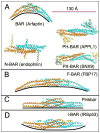Membrane curvature and its generation by BAR proteins
- PMID: 23058040
- PMCID: PMC3508348
- DOI: 10.1016/j.tibs.2012.09.001
Membrane curvature and its generation by BAR proteins
Abstract
Membranes are flexible barriers that surround the cell and its compartments. To execute vital functions such as locomotion or receptor turnover, cells need to control the shapes of their membranes. In part, this control is achieved through membrane-bending proteins, such as the Bin/amphiphysin/Rvs (BAR) domain proteins. Many open questions remain about the mechanisms by which membrane-bending proteins function. Addressing this shortfall, recent structures of BAR protein:membrane complexes support existing mechanistic models, but also produced novel insights into how BAR domain proteins sense, stabilize, and generate curvature. Here we review these recent findings, focusing on how BAR proteins interact with the membrane, and how the resulting scaffold structures might aid the recruitment of other proteins to the sites where membranes are bent.
Copyright © 2012 Elsevier Ltd. All rights reserved.
Figures



References
-
- Chen MS, et al. Multiple forms of dynamin are encoded by shibire, a Drosophila gene involved in endocytosis. Nature. 1991;351:583–586. - PubMed
-
- van der Bliek AM, Meyerowitz EM. Dynamin-like protein encoded by the Drosophila shibire gene associated with vesicular traffic. Nature. 1991;351:411–414. - PubMed
-
- Kosaka T, Ikeda K. Possible temperature-dependent blockage of synaptic vesicle recycling induced by a single gene mutation in Drosophila. Journal of neurobiology. 1983;14:207–225. - PubMed
-
- Takei K, et al. Functional partnership between amphiphysin and dynamin in clathrin-mediated endocytosis. Nature cell biology. 1999:33–39. - PubMed
Publication types
MeSH terms
Substances
Grants and funding
LinkOut - more resources
Full Text Sources
Other Literature Sources

